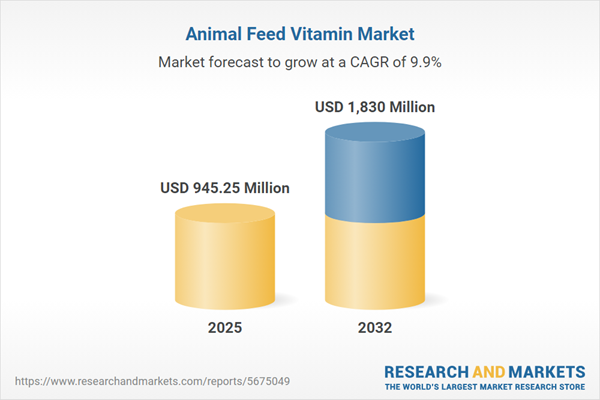Speak directly to the analyst to clarify any post sales queries you may have.
The animal feed vitamin market is evolving amid new regulations, technology-driven feed solutions, and emerging supply chain priorities. Senior leaders need focused intelligence to drive resilience and sustainable growth as operational demands shift within this sector.
Market Snapshot: Animal Feed Vitamin Market Growth and Trends
In 2024, the animal feed vitamin market is projected to reach USD 858.97 million, with anticipated growth to USD 945.25 million in 2025 and a compound annual growth rate (CAGR) of 9.92%. By 2032, forecasts indicate the market will achieve USD 1.83 billion. This positive momentum is attributed to innovation in feed manufacturing, the implementation of more rigorous compliance protocols, and increasing awareness of animal nutrition and welfare. Companies are meeting new challenges by advancing vitamin formulations, optimizing distribution strategies, and integrating sustainability practices in response to regulatory shifts. These developments impact both global and regional operators, compelling decision-makers to cultivate agile strategies that balance cost, quality, and stakeholder requirements.
Scope & Segmentation: Executive Insights for Animal Feed Vitamin Market
This report delivers targeted segmentation and actionable insights, empowering senior executives to make informed investment and operational decisions within this evolving market landscape.
- Animal Type: Assesses aquaculture, poultry, ruminants, and swine, supporting tailored nutrition strategies that enhance productivity and animal health outcomes for specific species groups.
- Vitamin Types: Reviews vitamins A, D3, E, and multivitamin blends, analyzing their functional significance for livestock performance, immunity, and growth optimization.
- Delivery Formats: Examines liquid, pellet, and powder forms, highlighting alignment with technological capabilities and precision-feeding objectives across production systems.
- End Users: Explores independent feed mills, vertically integrated producers, and on-site operators, clarifying roles and opportunities across the value chain to support collaboration and access.
- Regions: Evaluates market features in the Americas, Europe, Middle East & Africa, and Asia-Pacific, offering regulatory context and insight for region-specific growth and localization strategies.
- Leading Companies: Benchmarks industry participants such as Koninklijke DSM N.V., Adisseo S.A.S., BASF SE, Archer Daniels Midland Company, Evonik Industries AG, Novus International, Alltech, Kemin Industries, Phytobiotics Futterzusatzstoffe, and Zinpro Corporation, guiding partnership assessment and competitive positioning.
- Technologies: Outlines advancements in encapsulation, nano-dispersion, digital traceability, and real-time monitoring, addressing their roles in compliance, precision, and data-driven transparency initiatives.
Key Takeaways for Senior Decision-Makers
- Adoption of target-specific nutrition and encapsulation technologies is supporting improved animal health and precision nutrient delivery practices across feed sectors.
- Responsible sourcing of vitamins and transparent supply chains are gaining importance, as compliance requirements and stakeholder pressure demand greater traceability and sustainability across global operations.
- Utilization of IoT-enabled monitoring and advanced analytics is improving quality assurance, helping organizations quickly adjust to operational variations and uphold best-in-class production standards.
- Strategies centered on circular manufacturing and diversifying supply sources are top priorities to reduce risk and maintain continuity during market disruptions or supply interruptions.
- Agile management of regulatory shifts coupled with well-structured partnerships allows organizations to adapt sourcing and production approaches, ensuring they remain active in established and high-growth regions.
Tariff Impact on the Animal Feed Vitamin Market
Recent changes in United States tariff policy are driving greater emphasis on domestic sourcing for animal feed vitamins. This adjustment has fostered collaboration among feed mills, growers, and vitamin suppliers, encouraging integrated procurement practices to control costs and address risk. As a result, companies are enhancing resilience throughout the supply chain, strengthening stability, and better equipping themselves to navigate evolving regulatory and market challenges.
Methodology & Data Sources
Findings are grounded in structured interviews with senior executives from feed production, vitamin supply, and regulatory organizations. Insights are further validated through industry benchmarks, PESTLE, and SWOT analysis, ensuring data reliability and actionability for senior stakeholders.
Why This Report Matters
- Supports compliance, product innovation, and procurement strategies by providing leadership-focused market intelligence for informed executive decision-making.
- Offers transparent segmentation and robust industry benchmarking, enabling leadership teams to strengthen market positioning and allocate resources confidently for future initiatives.
- Guides adoption of emerging technologies and supply chain optimization, increasing operational efficiency and stability from sourcing to finished feed production.
Conclusion
Maintaining a competitive advantage in the animal feed vitamin sector requires proactive leadership, data-driven insight, and collaboration. This report equips executives to address sector complexities and pursue sustainable market opportunities with confidence.
Additional Product Information:
- Purchase of this report includes 1 year online access with quarterly updates.
- This report can be updated on request. Please contact our Customer Experience team using the Ask a Question widget on our website.
Table of Contents
3. Executive Summary
4. Market Overview
7. Cumulative Impact of Artificial Intelligence 2025
Companies Mentioned
The companies profiled in this Animal Feed Vitamin market report include:- Koninklijke DSM N.V.
- Adisseo S.A.S.
- BASF SE
- Archer Daniels Midland Company
- Evonik Industries AG
- Novus International, Inc.
- Alltech, Inc.
- Kemin Industries, Inc.
- Phytobiotics Futterzusatzstoffe GmbH
- Zinpro Corporation
Table Information
| Report Attribute | Details |
|---|---|
| No. of Pages | 196 |
| Published | October 2025 |
| Forecast Period | 2025 - 2032 |
| Estimated Market Value ( USD | $ 945.25 Million |
| Forecasted Market Value ( USD | $ 1830 Million |
| Compound Annual Growth Rate | 9.9% |
| Regions Covered | Global |
| No. of Companies Mentioned | 11 |









